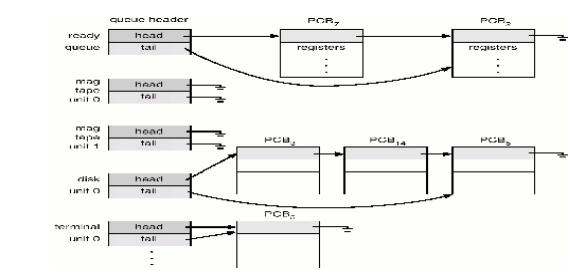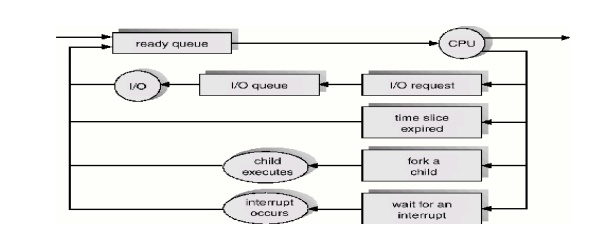Chapter: Operating Systems : Process Management
Process Scheduling
PROCESS SCHEDULING
ü The
objective of multiprogramming is to have some process running at all times, so
as to maximize CPU utilization.
ü Scheduling
Queues
There are 3 types of scheduling queues .They are :
ü
Job Queue
ü
Ready Queue
ü
Device Queue

ü As
processes enter the system, they are put into a job queue.
ü The
processes that are residing in main memory and are ready and waiting to execute
are kept on a list called the ready queue.
ü The list
of processes waiting for an I/O device is kept in a device queue for that
particular device.
ü A new
process is initially put in the ready queue. It waits in the ready queue until
it is selected for execution (or dispatched).
ü Once the
process is assigned tothe CPU and is executing, one of several events could
occur:
o
The process could issue an I/O request, and then
be placed in an I/O queue.
o The
process could create a new subprocess and wait for its termination.
ü The
process could be removed forcibly from the CPU, as a result of an interrupt,
and be put back in the ready Queue.
ü A common
representation of process scheduling is a queueing diagram.
Schedulers
ü A process
migrates between the various scheduling queues throughout its lifetime.
ü The
operating system must select, for scheduling purposes, processes from these
queues in some fashion.
ü The
selection process is carried out by the appropriate scheduler.
ü There are
three different types of schedulers.They are:
1. Long-term
Scheduler or Job Scheduler
2. Short-term
Scheduler or CPU Scheduler
3. Medium
term Scheduler
The long-term scheduler, or job
scheduler, selects processes from this pool and loads them into
memory for execution. It is invoked very in frequently. It controls the degree
of multiprogramming.
The short-term scheduler,
or CPU scheduler, selects from among the processes that are ready
to execute, and allocates the CPU to one of them. It is invoked very
frequently.
o Processes can be described as
either I/O bound or CPU bound.
o
An I\O-bound process spends more of its time doing
I/O than it spends doing computations.
o
A CPU-bound process, on the other hand, generates
I/O requests infrequently, using more of its time doing computation than an
I/O-bound process uses.
p
The system with the best performance will have a combination
of CPU-bound and I/O-bound processes.

The Medium term Scheduler
o
Some operating systems, such as time-sharing
systems, may introduce an additional, intermediate level of scheduling.
o
The key idea is medium-term scheduler, removes
processes from memory and thus reduces the degree of multiprogramming.
ü
At some later time, the process can be
reintroduced into memory and its execution can be continued where it left off.
This scheme is called swapping.
Related Topics